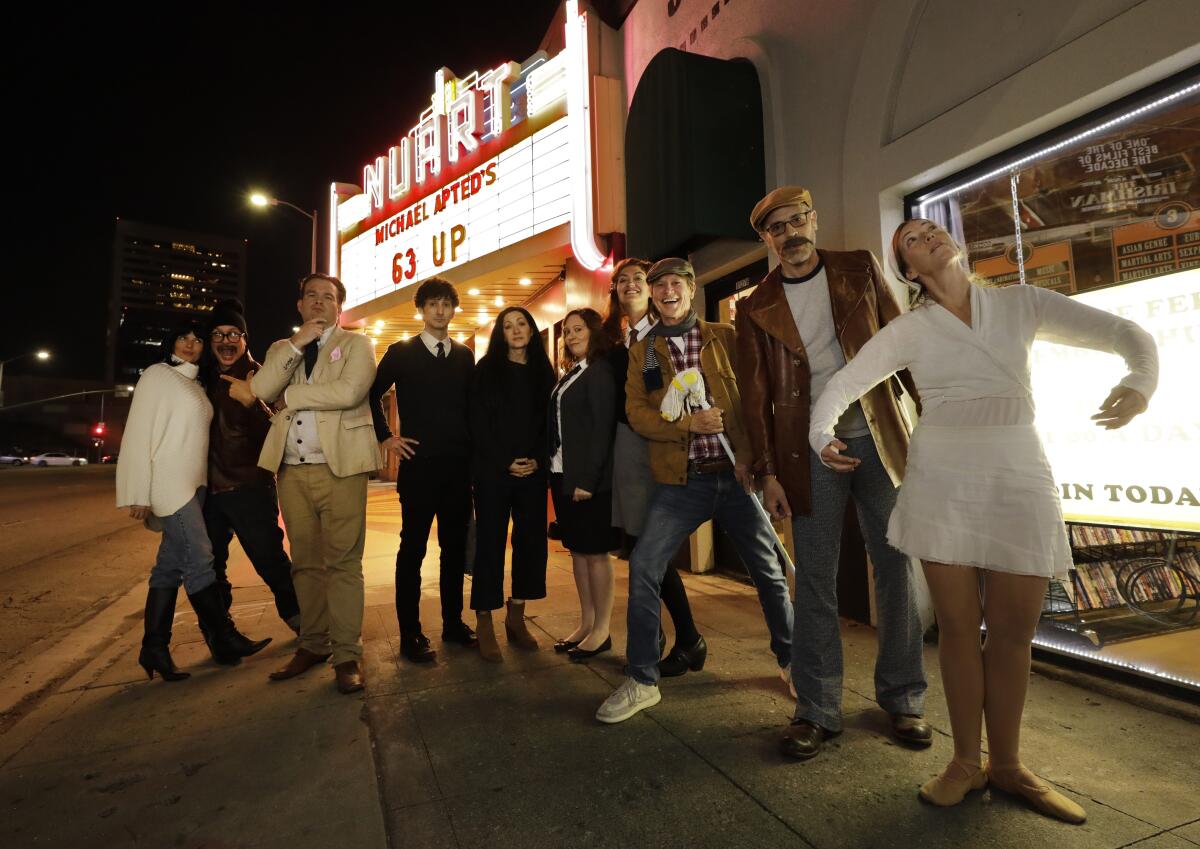They bonded over the end of an epic film saga. No, itâs not âStar Warsâ

Some came in street clothes. Some were in costume. One came on hobbyhorse. We few, we happy few, we band of binge watchers of British filmmaker Michael Aptedâs âUpâ series, assembled armed with high hopes â apologies to that other iconic U.K. director, Mike Leigh.
The mood was decidedly upbeat when a dozen of us arrived at the Nuart to see â63 Upâ (currently on view at Lumiere Music Hall). Weâd been gathering for weekly screenings of Aptedâs films in the run-up to the ninth and final installment of the documentary series, originally conceived as a sociological study of children: posh public schoolers, working-class East End youths, wards of the state. All save one of us were dressed as our favorite character â scratch that, as the formidable real folk who have courageously, if not always gamely, shared their lives onscreen with audiences every seven years since 1963.
The latest in Michael Aptedâs long-running documentary series that began with â7 Upâ is worth the wait.
Often it is the big tentpoles, like the âStar Warsâ saga, that inspire fellow travelers to communal viewings â and on the surface, the âUpâ series and the âStar Warsâ films, of the same number, seem galaxies far, far away. But peel away the special effects and they can essentially be seen as companion pieces: Both chronicle sons and daughters as they alternate between reconciliation with and rebellion against the socioeconomic stranglehold of a powerful Empire; and each serves as a contemplative but at times explosive dialectic on the question of predestination.
Yet as throngs streamed to theaters garbed as Wookiees, Sith and Jedi, from what I can glean, our merry band was the only costumed âUpâ watch group in either the U.K. or the U.S.
Our posse was the brainchild of Maggie Rowe, a TV writer and author of the memoirs âSin Bravelyâ and forthcoming âEasy Street.â âI love getting together with friends, but I hate parties and Iâm not a game personâ is Roweâs explanation. âIâd watched the series once through and always hoped to find like-minded people to compare notes with.â She enlisted her husband, Jim Vallely, a producer on âArrested Development,â to invite his friends too, in case no one responded. âThe first week, four people showed up,â she recalled. âSomehow, it grew to 16.â
If we were a tribute band, we might be the Uppers. We dedicated one night a week (with breaks for holidays, flus and â for one â a harmonica gig) to the minor accomplishments and major life challenges of âthe â7 Upâ kids,â the 14 original participants of the documentary.
A new film in the British series that has traced a group since childhood is planned; a boxed set arrives.
We guffawed at the reliable recap, included at the top of each installment, of the 7-year-oldsâ excursion to an âadventure playgroundâ â a veritable deathtrap junkyard, reminiscent of wreckage of the Death Star, where one child wields a pickax and another totes a splintery plank of wood. We emailed in feverish anticipation of each weekâs viewing. Before â42 Upâ: âLet there be BALD!â And Iâm not proud to admit it, but one of us, it might have been me, sent an email prior to â49 Upâ that read, âIâm just watching to see if one of them dies already!â Still, we genuinely worried over Neil, one of the seriesâ subjects, as his declining mental health led to a period of homelessness.
When the notion of dressing up for our theater outing was posited, email exchanges revealed just how steeped in the âUpâ lexicon weâd become. âHow about someone coming as a polar bear?â (as seen in a visit to a zoo) or âthat splintery plank of wood?â
That the Uppers are a loose friends-of-friends-of-friends affiliation might explain how we wound up with iterations of âthe kidsâ in different time periods â two of us coming as the same person (Paul) and one Upper declaring, âI want nothing to do with this ridiculous [redacted] enterpriseâ before joining us at the screening nonetheless.
Most memorable was Jim, who arrived on horse stick. Heâd spent much of his childhood on the small side, prior to an 11th-hour growth spurt, and like East Ender Tony had contemplated a career as a jockey. Etta Devine, a performer and filmmaker, proposed channeling the trio of East End working-class lasses whom Apted steadfastly refers to as âJackie and her friends.â Etta already had Jackieâs schoolgirl costume and her feisty attitude, while Maggie settled on one of the pals, Sue, in celebration of her steadfast dedication to making the best of whatever challenges life presents.
I was moved by the other pal, Lynn Johnson, and her life mission: a Sisyphean campaign to spread âthe beauty of booksâ to underserved children. One suspects that the sales force at Hollywood Toys & Costumes has fielded many an unusual request, but âI need a wig to look like âLynn,â you know, from â49 Upâ?â drew a blank stare. It was my first time at the store; Iâve never felt compelled to costume myself unsalaried.
At the Nuart, topped with my newly acquired $24.99 mane of dark locks, I attempted to channel Lynnâs indomitable spirit at age 49. Accompanied by impersonators of her pals at age 14, it made for a dissonant if heartfelt reunion.
Taking in our first screening in a public space, we tempered our ritual running commentaries, murmuring assent as someone whispered, âI wish Bruce [whoâd developed a paunch between â49â and â56â] would watch his weight,â and collectively sighing upon learning of Nickâs throat cancer. We couldnât resist hooting in solidarity as â rheumatoid arthritis be damned â a 63-years-fierce Jackie took on Aptedâs perennial failure of imagination regarding his female subjectsâ future outside of marriage and baby making. We wept with the revelation of Lynnâs passing. Someone cheered and clapped when a cozy corner of a childrenâs library was dedicated to her. OK, that was me.
As the credits rolled, having witnessed âthe kidsâ grow long in the tooth, one of us allowed, âI really need to be flossing more.â Jim and I, closest in age to the real-life Uppers, mulled over unfulfilled youthful ambitions and the fleeting fantasy of legacy. Jim summed up the satisfaction of the âUpâ series with deadpan comic perspective: âItâs like catching up with the best group of old friends that are never going to ask to come and live in your guest house.â
One is tempted to wonder how we appeared to other restaurant patrons at our postscreening drinks and dinner. In our odd array of outfits â adults in grade-school uniforms, mustachioed twins, a grown man astride a stick horse â we were a ragtag bunch. Bewigged, were we, perhaps, patients undergoing chemo and their supporters?
But the Uppers knew who we were â a modest confederation whoâd banded together in pursuit of a greater understanding of what it means to be human. For our effort, weâd been afforded an improbable and rare treat, practically a Tinseltown miracle: more than 17 among denizens of Hollywood, with nary a discussion of professions. We clung to one another just a bit longer than is seemly before merging into the night and the Los Angeles traffic, heading toward home and a new year buoyed by the most indefatigable force in this and any galaxy: community.
Annabelle Gurwitch is an actress and author of the essay collection âWherever You Go, There They Are: Stories About My Family You Might Relate to.â Sheâs at work on a new collection, âYouâre Leaving When?â
More to Read
Only good movies
Get the Indie Focus newsletter, Mark Olsen's weekly guide to the world of cinema.
You may occasionally receive promotional content from the Los Angeles Times.










